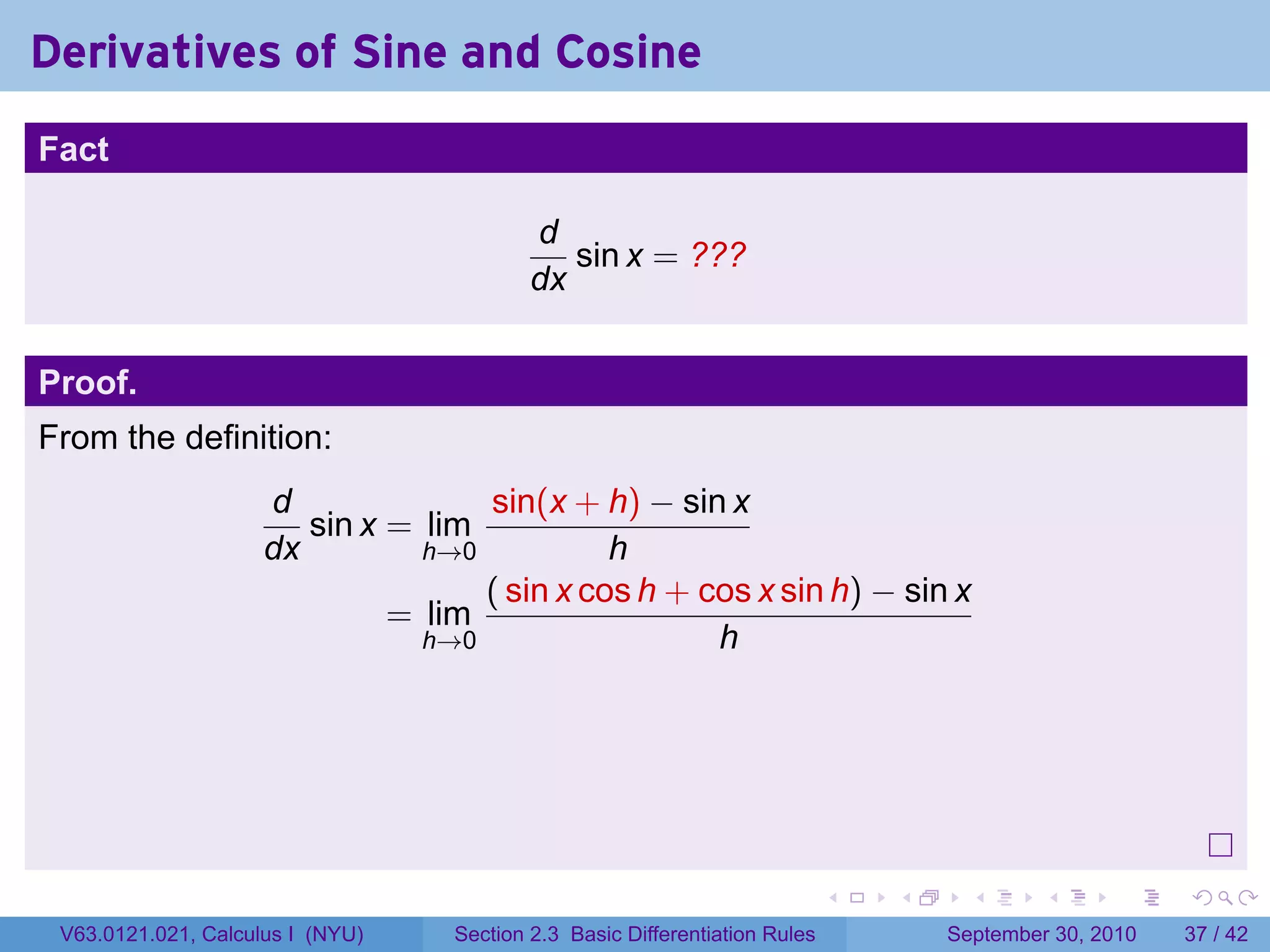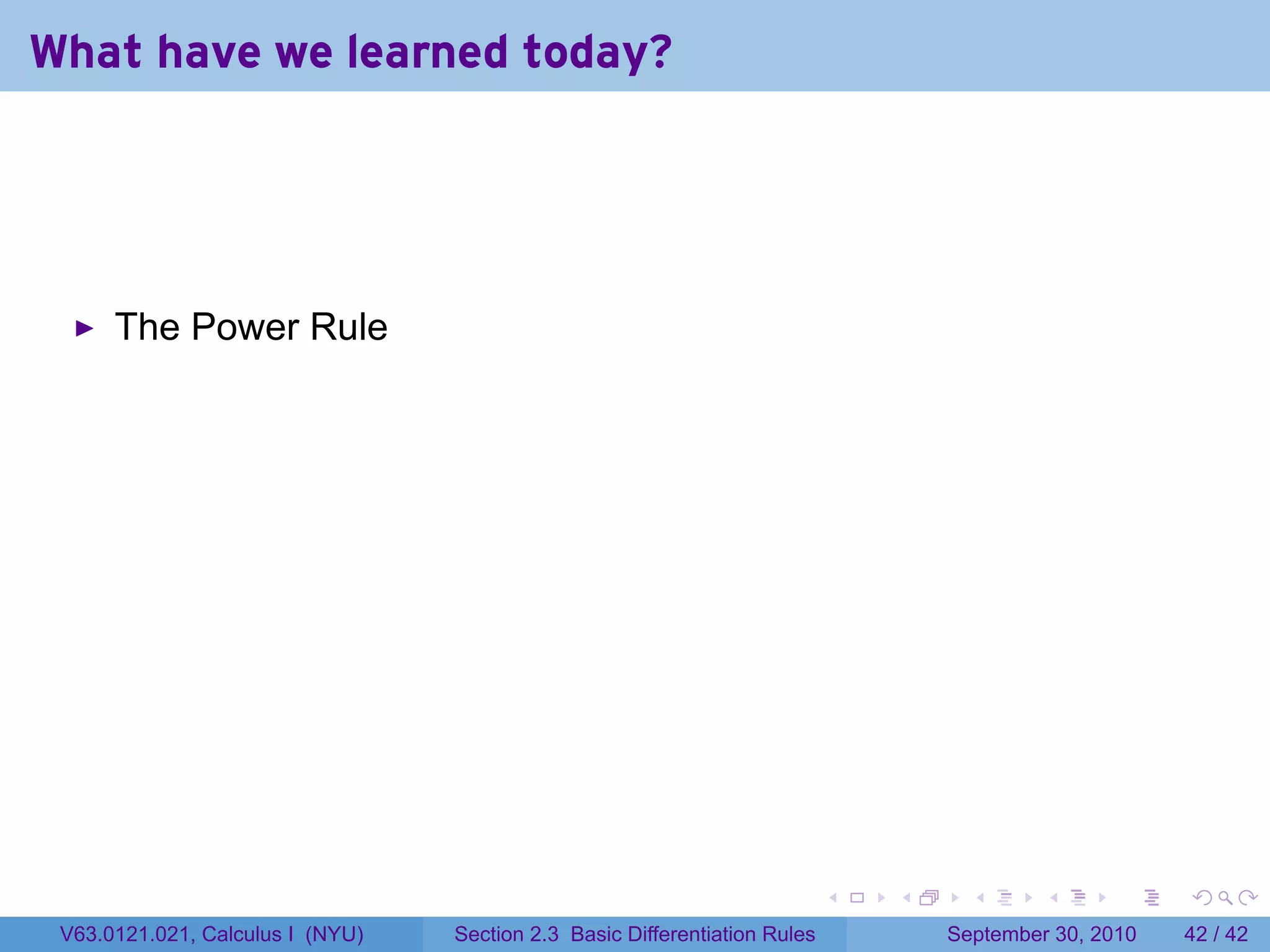This document is a section from a Calculus I course at New York University that discusses basic differentiation rules. It covers objectives like differentiating constant, sum, and difference functions. It also reviews derivatives of sine and cosine. Examples are provided, like finding the derivative of a squaring function x^2 using the definition of a derivative. The document outlines the topics and provides explanations and step-by-step solutions.



























































































![Recall the Limit Laws
Fact
Suppose lim f(x) = L and lim g(x) = M and c is a constant. Then
x→a x→a
1. lim [f(x) + g(x)] = L + M
x→a
2. lim [f(x) − g(x)] = L − M
x→a
3. lim [cf(x)] = cL
x→a
4. . . .
. . . . . .
V63.0121.021, Calculus I (NYU) Section 2.3 Basic Differentiation Rules September 30, 2010 28 / 42](https://image.slidesharecdn.com/lesson08basicdifferentiationrules021slidespdf2962-121002223002-phpapp02/75/Lesson-8-Basic-Differentiation-Rules-Section-21-slides-92-2048.jpg)


![Proof of the Sum Rule
Proof.
Follow your nose:
(f + g)(x + h) − (f + g)(x)
(f + g)′ (x) = lim
h→0 h
f(x + h) + g(x + h) − [f(x) + g(x)]
= lim
h→0 h
. . . . . .
V63.0121.021, Calculus I (NYU) Section 2.3 Basic Differentiation Rules September 30, 2010 30 / 42](https://image.slidesharecdn.com/lesson08basicdifferentiationrules021slidespdf2962-121002223002-phpapp02/75/Lesson-8-Basic-Differentiation-Rules-Section-21-slides-95-2048.jpg)
![Proof of the Sum Rule
Proof.
Follow your nose:
(f + g)(x + h) − (f + g)(x)
(f + g)′ (x) = lim
h→0 h
f(x + h) + g(x + h) − [f(x) + g(x)]
= lim
h→0 h
f(x + h) − f(x) g(x + h) − g(x)
= lim + lim
h→0 h h→0 h
. . . . . .
V63.0121.021, Calculus I (NYU) Section 2.3 Basic Differentiation Rules September 30, 2010 30 / 42](https://image.slidesharecdn.com/lesson08basicdifferentiationrules021slidespdf2962-121002223002-phpapp02/75/Lesson-8-Basic-Differentiation-Rules-Section-21-slides-96-2048.jpg)
![Proof of the Sum Rule
Proof.
Follow your nose:
(f + g)(x + h) − (f + g)(x)
(f + g)′ (x) = lim
h→0 h
f(x + h) + g(x + h) − [f(x) + g(x)]
= lim
h→0 h
f(x + h) − f(x) g(x + h) − g(x)
= lim + lim
h→0 h h→0 h
= f′ (x) + g′ (x)
Note the use of the Sum Rule for limits. Since the limits of the
difference quotients for for f and g exist, the limit of the sum is the sum
of the limits.
. . . . . .
V63.0121.021, Calculus I (NYU) Section 2.3 Basic Differentiation Rules September 30, 2010 30 / 42](https://image.slidesharecdn.com/lesson08basicdifferentiationrules021slidespdf2962-121002223002-phpapp02/75/Lesson-8-Basic-Differentiation-Rules-Section-21-slides-97-2048.jpg)






























